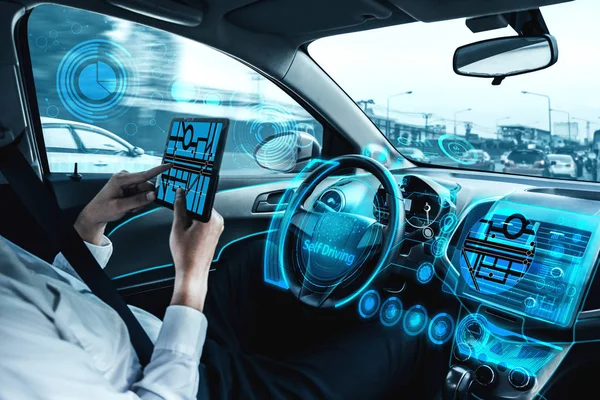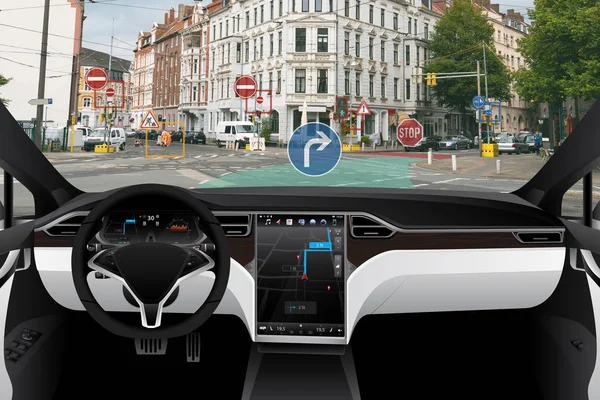Self-driving cars are one of the most exciting changes around us. In the past, people had to deal with traffic crashes, and the major problem was pollution from gas-powered cars. The idea of cars that drive themselves seemed like a smart way to fix these problems. But building such cars hasn’t been easy. There are still big challenges that companies face in manufacturing these cars. In this article, we’ll look at how companies are working hard to move this technology forward, step by step.

In these few years, self-driving car technology has improved a lot. They have smarter artificial intelligence (AI), better sensors, and stronger internet connections. These cars can now understand roads and then make decisions based on them. Some driverless taxis and trucks are already being tested in certain cities. Cities are also experimenting with small self-driving shuttles for public transportation. At the same time, experts are working hard to make sure these cars are safe from crashes and cyberattacks. However, even after these advancements, companies still face several challenges.
Despite the advanced technologies employed by self-driving cars, certain safety concerns remain. Sometimes, the software might crash, which can be dangerous. There have even been many accidents, including a few fatal ones. These things force people to think about the safety of these cars. On the other side, Human drivers, despite making mistakes, have a very strong safety record. Additionally, there’s a risk of someone hacking into these systems and gaining control of the car. Due to all this, many people still don’t fully trust autonomous vehicles.
Self-driving cars rely on sensors such as cameras, radar, and LiDAR. But these sensors still have some problems. They generate a vast amount of data, and the car requires powerful computers to quickly process it all. If the system is too slow, it will not process some actions. Also, some sensors still can’t detect small or faraway objects fast enough. Another issue is that these cars require multiple sensors to work together, as a single failure can compromise the system, which adds to the overall cost. In busy cities or forested areas, GPS signals can also get weak.
The production cost of autonomous vehicles is really high. These cars have advanced software to work safely. This adds a lot of cost. sometimes as much as $10,000 to $100,000 more than a regular car. Big companies like Tesla, Waymo, and Cruise have already spent billions of dollars trying to make this technology work. They also spend a lot on testing, mapping, and running fleets of robotaxis. For example, the maps used by these cars must be extremely accurate. Right now, all of this makes self-driving cars too costly for most people. The good news is that, over time, as production increases, these costs are expected to decrease.
Self-driving cars are still facing many legal and regulatory problems. It slows down their progress. Different countries have different laws. Many of them are still trying to figure out how to deal with this new technology. It's also hard for companies to test or sell these cars in many areas because the approval process is complicated. Additionally, some laws still require cars to have steering wheels and pedals. Countries like China and Japan are moving faster with better laws, but others are still behind. There’s also a need for better road technology and ways to protect these cars from hacking.
Self-driving cars use smart technology to drive safely. But these same tools can also open the door to cyberattacks. Hackers might be able to take control of the car remotely, potentially leading to accidents. These cars also collect a lot of personal data. If someone steals that data, it can lead to privacy issues. Since these vehicles are always connected to other cars and systems on the road, there are even more opportunities for hackers to gain access. That's why keeping these cars safe from cyber threats is so important. Car companies and governments are working on better safety systems. However, protecting self-driving cars from hackers remains a significant challenge that requires ongoing attention.
In some rare cases, the car might have to decide who to protect in an accident. This kind of decision is very difficult, and there’s no easy answer. It’s also unclear who should be blamed if something goes wrong: the car, the company, or the person riding in it. Another issue is deciding when the car should give control back to the human driver in dangerous situations. Additionally, these cars collect a significant amount of data, which raises concerns about privacy.
For self-driving cars, cities need to update their roads and systems. Currently, most roads, traffic lights, and signs are designed for human drivers. But autonomous vehicles (AVs) rely on smart technology. So, they need clearer road markings and signs that computers can read. Traffic lights should also be smarter. In the future, some cities might create special lanes or areas just for AVs.

Even though autonomous vehicles are facing big challenges, they are still growing fast around the world. More than 6,000 companies are working on this technology, and the market is growing at a rate of over 17% annually. Research states that the market will grow from about $273 billion in 2025 to over $4 trillion by 2034.
To deal with the problems, companies are also working closely with governments to create clear rules. Some companies are testing robotaxis and driverless shuttles in controlled areas to learn more. As technology advances and costs decrease, self-driving cars are becoming increasingly practical.
Self-driving cars are changing more than just how we drive. They can also help people who are unable to drive. This new technology brings many chances for new ideas and teamwork. It also changes how we think about transport and safety. To make this future a reality, everyone needs to contribute: governments, companies, and individuals. We should learn about the technology and talk about the complex problems. We also need rules that support safety and growth. Together, we can build a safer and smarter future with self-driving cars.

Explore how Advanced Topic Modeling with LLMs transforms SEO keyword research and content strategy for better search rankings and user engagement.

How to evaluate Agentic AI systems with modern metrics, frameworks, and best practices to ensure effectiveness, autonomy, and real-world impact in 2025.

AIOps redefines IT operations by leveraging AI to reduce costs, enhance efficiency, and drive strategic business value in a digital-first world.

Selector is a versatile platform for anomaly detection and network security, using advanced AI for precise threat identification and prevention.

How IT monitoring platforms enhance system reliability, enable faster issue resolution, and promote data-driven decisions.

How AI-powered automation is transforming network operations, delivering efficiency, scalability, and reliability with minimal human intervention.

How AI enhances forecasting accuracy while addressing limitations like rare events and data quality through human-AI collaboration.

Find out how to stop X from using your posts to train its AI models.

Explore how ChatGPT’s AI conversation feature works, its benefits, and how it impacts user interactions.

How data mining empowers businesses with insights for smarter decisions, improved efficiency, and a competitive edge.

Google’s Gemini Live now works on most Android phones, offering hands-free AI voice assistance, translations, and app control

Google’s Gemini 2.0 boosts AI speed, personalization, and multi-modal input with seamless integration across Google apps